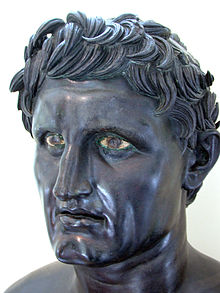Seleucus Nicator
| Seleucus I Nicator | |
|---|---|
| Basileus of the Seleucid Empire | |

A Roman copy of a Greek statue of Seleucus I found in Herculaneum. Now located at the Naples National Archaeological Museum.
|
|
| Basileus of the Seleucid Empire | |
| Reign | 305–281 BC |
| Predecessor | Alexander IV of Macedon |
| Successor | Antiochus I Soter |
| Born | c. 358 BC Macedon |
| Died | 281 BC (aged c. 77) Thrace |
| Spouse |
Apama of Sogdiana Stratonice of Syria |
| Issue | Apama Antiochus I Soter Achaeus Phila |
| Dynasty | Seleucid dynasty |
| Father | Antiochus |
| Mother | Laodice |
| Religion | Greek polytheism |
Seleucus I Nicator/səˈljuːkəs naɪˈkeɪtər/ (c. 358 BC – 281 BC; Ancient Greek: Σέλευκος Νικάτωρ) was one of the Diadochi. Having previously served as an infantry general under Alexander the Great, he eventually assumed the title of basileus and established the Seleucid Empire over much of the territory in the Near East which Alexander had conquered.
After the death of Alexander in June 323 BC, Seleucus initially supported Perdiccas, the regent of Alexander's empire, and was appointed Commander of the Companions and chiliarch at the Partition of Babylon in 323 BC. However, after the outbreak of the Wars of the Diadochi in 322, Perdiccas' military failures against Ptolemy in Egypt led to the mutiny of his troops in Pelusium. Perdiccas was betrayed and assassinated in a conspiracy by Seleucus, Peithon and Antigenes in Pelusium sometime in either 321 or 320 BC.
...
Wikipedia
